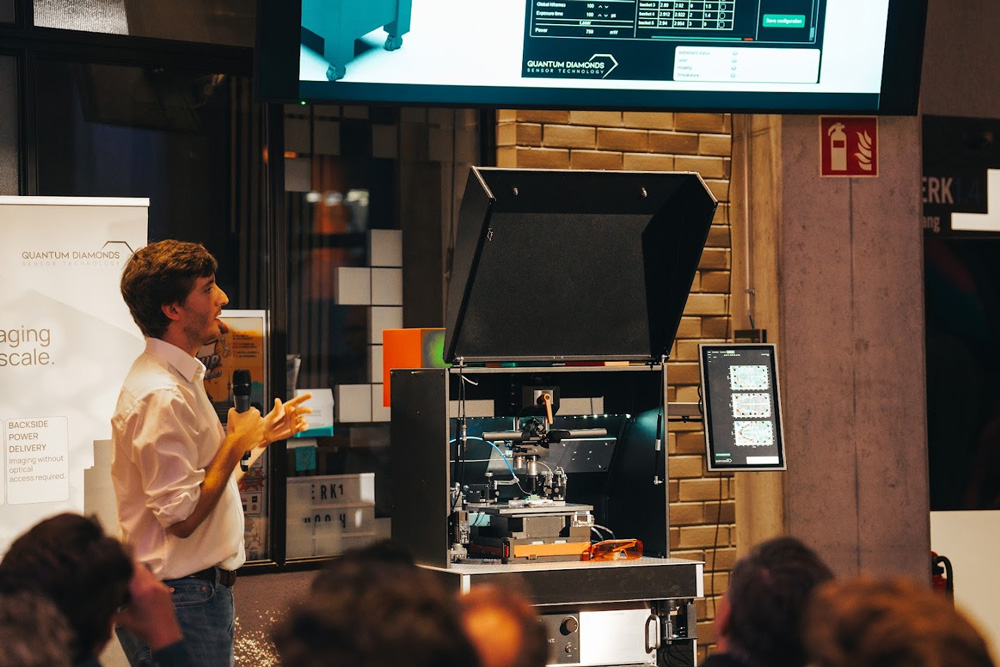A project of QuantumDiamonds GmbH

Transparent quantification of environmental impact
The project goal of the life cycle assessment is to transparently quantify the environmental impact of a quantum-based testing device from QuantumDiamonds GmbH (QD) in semiconductor manufacturing. Precise error analysis is intended to increase production efficiency (yield), leading to significant savings in resources such as water, electricity, and raw materials. A 1% improvement in yield could save millions of euros and significantly reduce CO₂ emissions. Overall, the project aims to comprehensively assess the ecological and economic impact of quantum-based error analysis in semiconductor manufacturing, reduce the ecological footprint of semiconductor manufacturing, and increase economic benefits at the same time.
Precise error detection through quantum-based magnetometry
The innovative approach of QD's test device is based on quantum-based magnetometry, which enables the non-destructive and precise visualization of current distributions in semiconductor chips. Unlike conventional methods, this technology significantly improves error detection and reduces scrap in chip production. By identifying defects in a targeted manner, manufacturers can optimize their process parameters, resulting in higher production yields and lower material losses. In addition, improved error analysis reduces energy consumption in manufacturing. The life cycle assessment quantifies the positive environmental impact of this technological innovation and contributes to the sustainable design of the entire value chain.
Calculation of the carbon footprint in the production and usage phases
In this project, Fraunhofer IZM will determine the product carbon footprint (PCF) of the testing device for the production and usage phases based on a simplified life cycle assessment, with a focus on the usage phase. In close cooperation with QD and Fraunhofer EMFT, a life cycle assessment model is being developed to determine the PCFs of the selected products and make the results available at the end of the project. In addition, Fraunhofer IZM is estimating the handprint of quantum-based testing by modeling the emission savings achieved through the targeted increase in yield in semiconductor chip manufacturing.
Development of scenarios to save GWP and resources
In collaboration with Fraunhofer EMFT and QD, two to three different scenarios are being developed to determine savings in global warming potential and material consumption. Fraunhofer EMFT is providing device-specific information, measuring the power consumption of the test device, and analyzing the potential of diamond microscopy for error analysis compared to conventional methods.
Sustainable use of life cycle assessment results
After the project ends, the results of the life cycle assessment will be used in a variety of ways. They will serve as a basis for communication with customers and partners by transparently demonstrating the resource savings and environmental benefits of the testing device. In addition, the data obtained will enable the optimization of production processes, the preparation of certifications, and the fulfillment of legal environmental requirements. The results can also be used as a basis for future research and innovation projects to develop resource-efficient technologies and manufacturing processes, which increases competitiveness and supports sustainable strategies in industry.
Fraunhofer IZM will further develop the handprinting method and refine its data models for semiconductor manufacturing. Fraunhofer EMFT is gaining insights into the ecological balance of the diamond microscope and evaluating the savings potential offered by diamond microscopy measurements. In addition, Fraunhofer EMFT is conducting numerous discussions with international semiconductor manufacturers and is involved in international standardization, which serves as a selling point for measurement services using the diamond microscope and supports the establishment of this method in the semiconductor market.
Project Partners:
Henrik Scholz, QuantumDiamonds GmbH
Fraunhofer Institute for Reliability and Microintegration IZM
Fraunhofer Institute for Electronic Microsystems and Solid State Technologies EMFT
Project period:
Start: 01.06.2025, End: 30.11.2025
